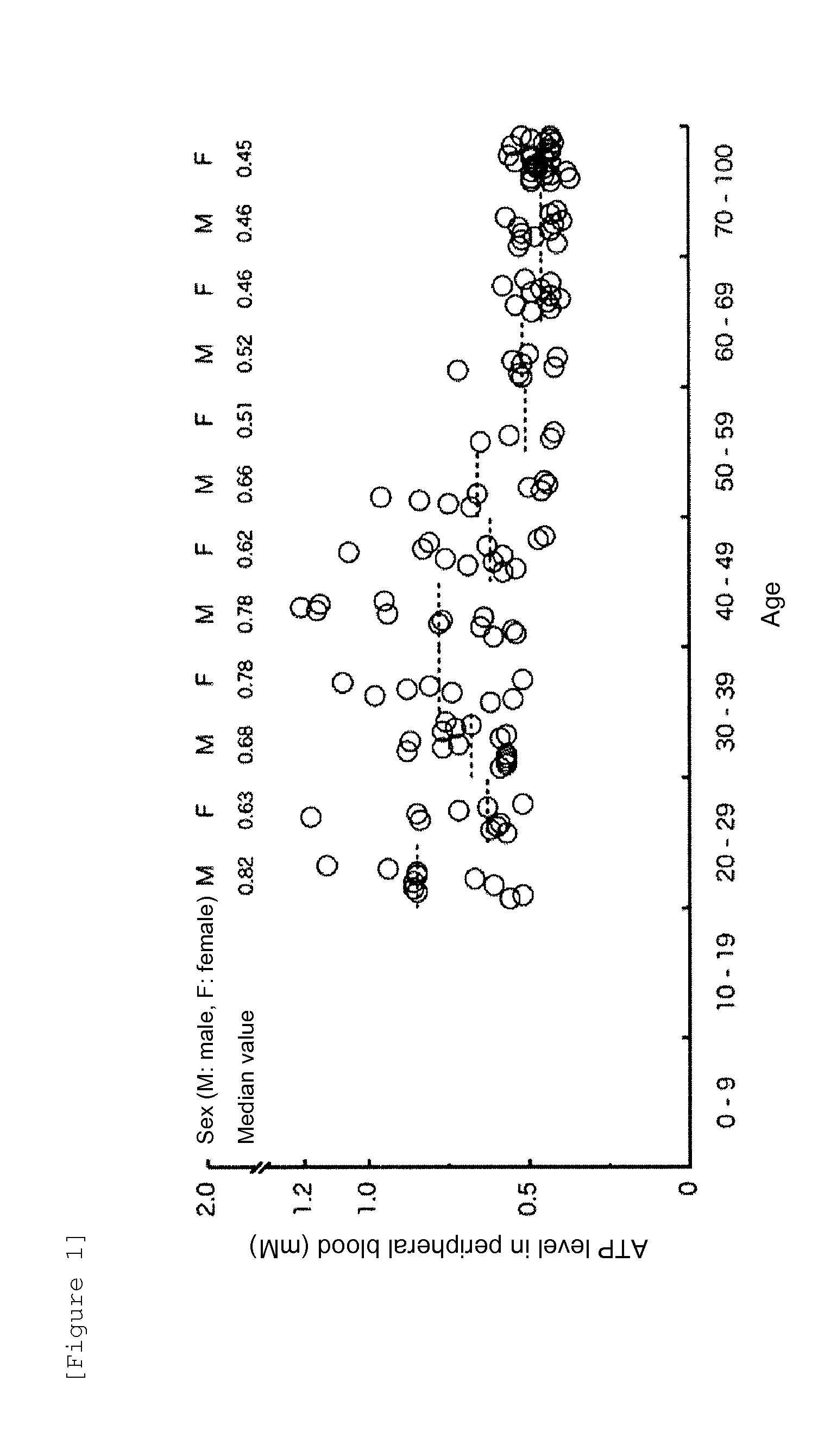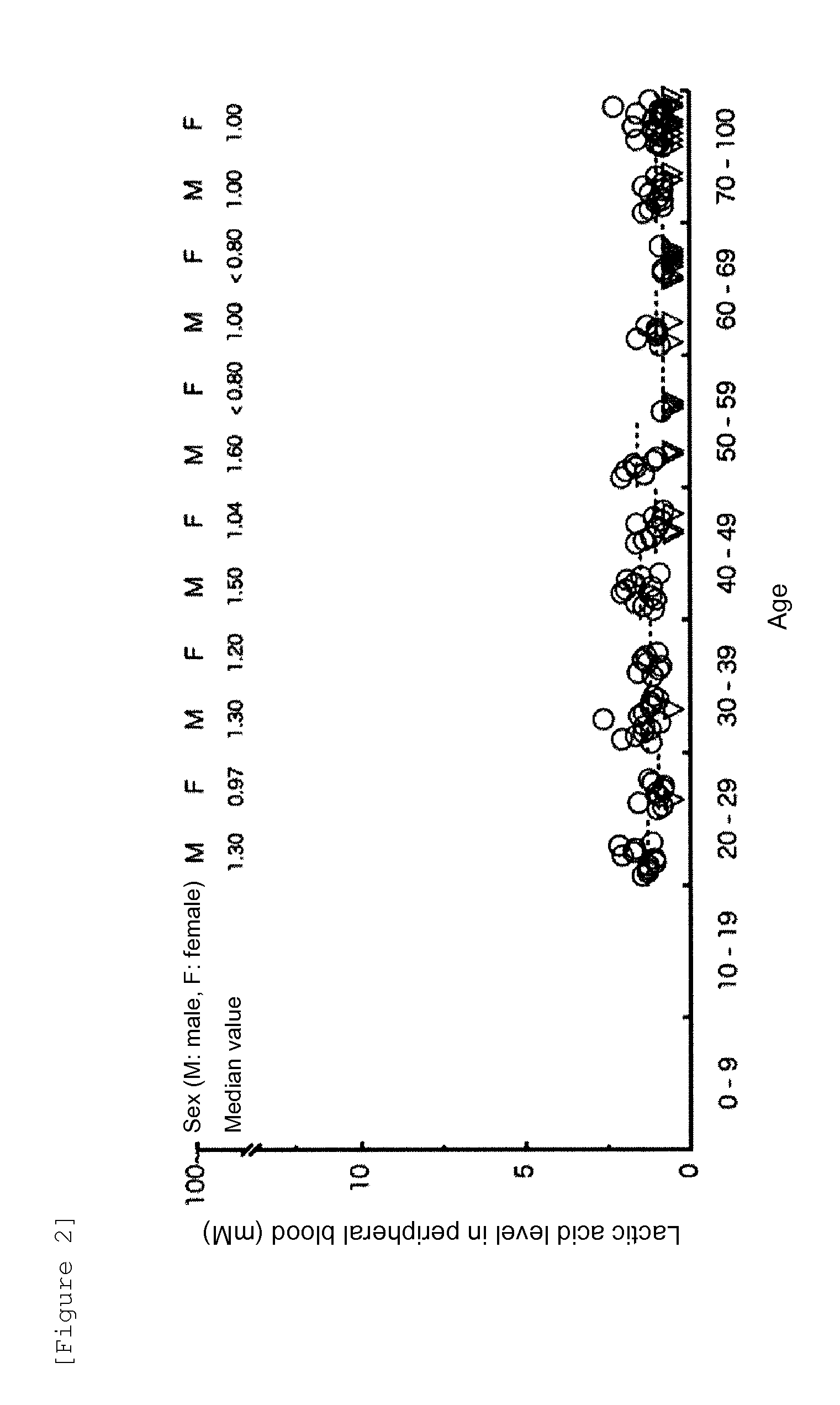Method for testing the severtiy of an illness
a technology for illness severity and diagnosis, applied in the field of diagnosis of illness severity, can solve the problems of difficult inability to accurately deduce the “state of intracellular energy required for living organisms, etc., to achieve accurate deduction of “state and high mortality risk
- Summary
- Abstract
- Description
- Claims
- Application Information
AI Technical Summary
Benefits of technology
Problems solved by technology
Method used
Image
Examples
reference example 1
Study on the Distributions of ATP Levels in Healthy Individual-Derived Samples, Ages, and Sexes
[0042]In this Reference Example, ATP levels and lactic acid levels in the peripheral venous blood of 139 healthy volunteers in total consisting of 68 males and 71 females in their 20s to 90s were measured for the purpose of figuring out ATP levels in healthy individual-derived samples to establish the method for testing the severity of an illness according to the present invention.
[0043]The ATP levels were measured after ATP extraction from the samples using XL-ATP kit (manufactured by APRO Life Science Institute, Inc.) according to the instruction manual. The reagent for ATP extraction used was a mixture of extraction reagent A (TE-saturated phenol, component: containing 69% phenol, pH 8.0) and extraction reagent B (chloroform, component: containing 99% chloroform) included in the kit and sterile ultrapure water at a ratio of 3:5:5 respectively. Specifically, 0.1 ml of the blood collected...
reference example 2
Study on the Distributions of Lactic Acid Levels in Healthy Individual-Derived Samples, Ages, and Sexes
[0045]In this Reference Example, lactic acid levels in the peripheral venous blood of 139 healthy volunteers in total shown in Reference Example 1 were measured for the purpose of figuring out lactic acid levels in healthy individual-derived samples. The lactic acid levels were measured using a fully automatic blood gas analyzer (Bayer 860COT; Bayer HealthCare AG) or a simple analyzer (Lactate Pro; ARKRAY, Inc.) according to the measurement method recommended by each manufacturer.
[0046]The distributions of the measured lactic acid levels (mM) in the healthy individual-derived samples shown in Tables 1 and 2, and the ages and sexes of the healthy individuals are shown in FIG. 2. The lactic acid levels in the peripheral venous blood of 139 healthy volunteers in total did not exhibit the statistically significant difference among ages or between males and females. The median value was...
reference example 3
Study on the Distributions of A-LES Values Calculated from ATP Levels and Lactic Acid Levels in Healthy Individual-Derived Samples, and the Ages and sexes of the healthy individuals
[0047]This Example was intended to figure out A-LES values in healthy individuals on the basis of the measured ATP levels and lactic acid levels in the healthy individual-derived samples obtained in Reference Examples 1 and 2.
[0048]The A-LES values were calculated according to the following formula I:
A-LES value=Lactic acid level (L; mM) / ATP level (a; mM) (Formula I)
[0049]The distributions of the A-LES values in the healthy individual-derived samples shown in Tables 1 and 2, and the ages and sexes of the healthy individuals are shown in FIG. 3. The A-LES values in 139 healthy volunteers in total consisting of 68 males and 71 females in their 20s to 90s did not exhibit the statistically significant difference among ages or between males and females. The median value was shown to be 1.99 in the males in th...
PUM
| Property | Measurement | Unit |
|---|---|---|
| pH | aaaaa | aaaaa |
| pH | aaaaa | aaaaa |
| pH | aaaaa | aaaaa |
Abstract
Description
Claims
Application Information
 Login to View More
Login to View More - R&D
- Intellectual Property
- Life Sciences
- Materials
- Tech Scout
- Unparalleled Data Quality
- Higher Quality Content
- 60% Fewer Hallucinations
Browse by: Latest US Patents, China's latest patents, Technical Efficacy Thesaurus, Application Domain, Technology Topic, Popular Technical Reports.
© 2025 PatSnap. All rights reserved.Legal|Privacy policy|Modern Slavery Act Transparency Statement|Sitemap|About US| Contact US: help@patsnap.com



